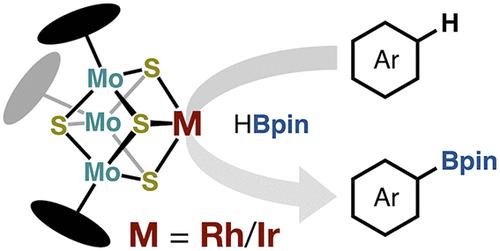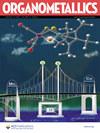Synthesis of Cubic [Mo3S4M] (M = Rh, Ir) Clusters for the Borylation of C–H Bonds in Aromatic Compounds
IF 2.5
3区 化学
Q2 CHEMISTRY, INORGANIC & NUCLEAR
引用次数: 0
Abstract
The incorporation of Rh or Ir into the [Mo3S4] platforms of [CpXL3Mo3S4] or [Cp*3Mo3S4] (CpXL = C5Me4SiEt3, Cp* = C5Me5) led to the formation of cubic [Mo3S4M] clusters, [CpXL3Mo3S4Rh(cod)] (1), [CpXL3Mo3S4Ir(coe)] (2), [Cp*3Mo3S4Rh(coe)] (3), and [Cp*3Mo3S4Ir(coe)] (4) (cod = 1,5-cyclooctadiene, coe = cyclooctene). These clusters were characterized spectroscopically and crystallographically. They catalyzed the C–H borylation of aromatic compounds (benzene, toluene, o-xylene, m-xylene, and p-xylene) in the presence of HBpin (4,4,5,5-tetramethyl-1,3,2-dioxaborolane), yielding the corresponding borylated products. Among these, cluster 3 exhibited the highest catalytic activity, while the treatment of cluster 2 with excess HBpin generated a millisecond-detectable potential intermediate, [CpXL3Mo3S4Ir(Bpin)]+. Despite the high affinity of Lewis acidic boron toward sulfur, the robust [Mo3S4M] (M = Rh, Ir) cubes protected adequately by Cp ligands have proven effective in borylation chemistry.

用于芳香族化合物中 C-H 键硼化的立方 [Mo3S4M](M = Rh、Ir)团簇的合成
在[CpXL3Mo3S4]或[Cp*3Mo3S4](CpXL = C5Me4SiEt3,Cp* = C5Me5)的[Mo3S4]平台中加入 Rh 或 Ir 会形成立方体[Mo3S4M]团簇、[CpXL3Mo3S4Rh(cod)] (1)、[CpXL3Mo3S4Ir(coe)] (2)、[Cp*3Mo3S4Rh(coe)] (3) 和 [Cp*3Mo3S4Ir(coe)] (4)(cod = 1,5-环辛二烯,coe = 环辛烯)。对这些簇合物进行了光谱学和晶体学表征。它们在 HBpin(4,4,5,5-四甲基-1,3,2-二氧杂硼硼烷)存在下催化了芳香族化合物(苯、甲苯、邻二甲苯、间二甲苯和对二甲苯)的 C-H 硼酰化反应,生成了相应的硼酰化产物。其中,簇 3 表现出最高的催化活性,而用过量的 HBpin 处理簇 2 则会产生毫秒级可检测到的潜在中间产物 [CpXL3Mo3S4Ir(Bpin)]+。尽管路易斯酸性硼对硫具有很高的亲和力,但在 Cp 配体的充分保护下,坚固的 [Mo3S4M](M = Rh、Ir)立方体在硼化化学中被证明是有效的。
本文章由计算机程序翻译,如有差异,请以英文原文为准。
求助全文
约1分钟内获得全文
求助全文
来源期刊

Organometallics
化学-无机化学与核化学
CiteScore
5.60
自引率
7.10%
发文量
382
审稿时长
1.7 months
期刊介绍:
Organometallics is the flagship journal of organometallic chemistry and records progress in one of the most active fields of science, bridging organic and inorganic chemistry. The journal publishes Articles, Communications, Reviews, and Tutorials (instructional overviews) that depict research on the synthesis, structure, bonding, chemical reactivity, and reaction mechanisms for a variety of applications, including catalyst design and catalytic processes; main-group, transition-metal, and lanthanide and actinide metal chemistry; synthetic aspects of polymer science and materials science; and bioorganometallic chemistry.
 求助内容:
求助内容: 应助结果提醒方式:
应助结果提醒方式:


